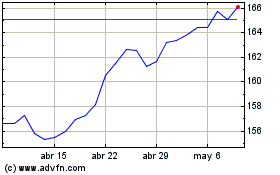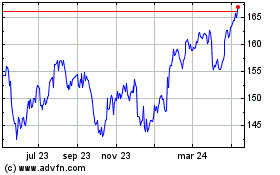By Sharon Terlep
Almost every day an employee at Procter & Gamble Co.'s plant
in Albany, Ga., a town with one of the nation's highest rates of
coronavirus, learns that someone close has become seriously ill or
died of Covid-19.
There is little time for consolation between co-workers. They
are all racing to churn out one of the most in-demand products in
America: toilet paper.
"It's a lot quieter here than it used to be," said John
Patterson, a 16-year veteran of the plant, which makes Charmin
toilet paper alongside Bounty paper towels. Workers, who must stay
6 feet apart, console one another over headsets and on video
calls.
P&G, which produces household staples from Tide detergent to
Pampers diapers, is the biggest U.S. maker of toilet paper with
close to 30% of the market. The sprawling Albany factory, one of
six that make toilet paper, is P&G's second-largest U.S. plant.
It makes products that generate roughly $1.3 billion in annual
sales, according to the Georgia Manufacturing Alliance.
The factory has ramped up production by 20% of both toilet paper
and paper towels, even as it revamps its operations to keep its
roughly 600 workers healthy. Among other measures, it has
instituted pre-shift temperature checks and staggered start times.
P&G declined to comment on whether employees have tested
positive.
The plant sits in a midsize town of 75,000 people ravaged by the
new coronavirus. More than 1,020 people have tested positive in
Dougherty County, which includes Albany, and 62 have died as of
Thursday afternoon. More people have died in the county than in
Fulton County, which includes Atlanta and has a population more
than 10 times larger.
Health officials trace the spread of coronavirus in Albany to a
late-February funeral that drew more than 100 mourners, including a
man who later died of Covid-19.
In mid-March, Albany Mayor Bo Dorough received word from county
health officials that a few residents had tested positive for
coronavirus. Officials thought the cases were isolated instances.
"We thought it was an anomaly," Mr. Dorough said. "But after those
three deaths, things just started to cascade downward and it hasn't
stopped since."
The community and the factory have been through rough stretches.
Albany has among the state's highest rates of crime and poverty. In
2018, a hurricane wiped out power for days to thousands in the
community. A year before that, a tornado leveled the warehouse at
the P&G complex.
Around the same time Mr. Dorough was learning of the first
deaths in his town, executives at P&G's Cincinnati headquarters
were strategizing about how to ramp up production. The company had
already mobilized safety plans in the U.S. that it had previously
put in place in China, the company's second-largest market.
"I started to realize, this isn't going to skip over us," said
Rick McLeod, who oversees product supply for P&G's family care
unit, which includes toilet paper. "There were cues that this is
going to be a big deal. Then the floodgates opened and everyone
realized the seriousness."
The state of Georgia and the U.S. Department of Homeland
Security consider the plant an essential business, so it has
remained open as offices, shops and restaurants close throughout
the rest of the state.
Demand for toilet paper shot up in the outbreak's initial weeks,
doubling in the second week of March, according to Nielsen. Before
the surge, Americans spent roughly $9 billion a year on toilet
paper. The internet flooded with memes and jokes about
toilet-tissue scarcity, as well as tales of serious panic. P&G
added a prerecorded message to Charmin's toll-free line
specifically for people hunting for toilet paper.
While Americans aren't using more toilet paper amid the
pandemic, they are going through substantially more at home. The
thin, scratchy tissue found in office bathrooms and public
restrooms is different enough that it is generally built at
separate plants -- with different supply chains -- and can't be
redirected to store shelves overnight, said analyst Jonathan Rager
of Fastmarkets RISI, an analytics firm specialized in the pulp and
paper industry.
Making toilet paper in bulk requires a massive machine, a
four-story-tall collection of intricately pieced-together parts,
which costs billions of dollars and takes months to build.
Bathroom tissue begins with wood chips that are turned into
pulp. The machinery cleans the pulp and feeds it through massive
rollers that soak out any water. The pulp is then chemically
whitened and then spread on a screen and put through a hot dryer,
emerging as a delicate sheet of paper that gets rotated into a
spool. A single spool can hold close to 50 miles of paper, which is
then embossed both for aesthetics and to thicken the sheets.
A separate machine constructs cardboard into tubes roughly
five-feet long. Two sheets of the finished paper are combined to
make two-ply tissue, which is then wrapped around the cardboard
tubes. A machine seals the roll with a light glue and then a
circular saw cuts the long roll into bathroom-sized rolls that are
packaged and loaded for delivery.
A big toilet paper operation could churn out a few million
individual paper rolls a day, with that number varying
significantly based on how many lines the factory devotes to toilet
paper and the type and size of each roll, said Mr. Rager of
Fastmarkets.
Quickly changing over a line or adding production at another
factory wasn't an option for P&G. But in Albany, P&G had an
idled piece of equipment that, if put to use, could increase
volume.
Setting up the equipment to help make the current product, and
staffing it with workers trained to use it, would typically take
months for Albany's team of 10 technicians. So P&G sent a
half-dozen engineers from other plants to help. The equipment was
operational within two weeks, but the company had another problem.
The engineers' return flights had been canceled as airlines shut
down amid the virus's spread.
P&G CEO David Taylor, whose early career included a
three-year stint in the 1980s as an operations manager of the
Albany factory, directed a corporate jet to be sent to Georgia to
retrieve the workers and take them home to Missouri and
Pennsylvania.
Mr. McLeod, the P&G executive, also started his career at
the Albany plant and lived there nearly a decade. His voice cracked
as he talked about a retired technician, in her late 60s, whom he
supervised in his early days who died of Covid-19, along with her
daughter, who was in her early 40s. Earlier that day, he learned
that an Albany employee lost their father.
"The more we can serve our consumers the better it is for
everyone," he said. "If they can just see some product in the
store, it will help. There's a sense of pride of being able to
deliver that thing that's so needed right now."
Increasing production while keeping workers safe is a challenge
for many U.S. employers, from meatpackers to factories making
hospital ventilators. P&G has started producing face masks and
hand sanitizer for its employees, as well as for medical
workers.
Overtime is eschewed because putting workers on an extra shift
with a different crew exposes more people should someone become
infected. If a worker becomes ill, their entire team goes into
quarantine.
P&G, at all its factories including Albany, checks workers'
temperatures at the start of their shifts. Start times and lunch
breaks are staggered to avoid lines at the doors or people sitting
close on breaks. The cafeteria has no salad bar or open food, just
prepackaged options. Team meetings are generally held over video,
even if everyone is at the plant.
Mr. Patterson, the P&G plant veteran, said the hardest thing
is having to maintain distance from friends and family who are
struggling.
"In other times we could be there to console folks in their time
of need, really display that Southern hospitality," he said,
recalling the aftermath of the hurricane and tornado that hit
Albany. His wife, who is a furloughed nurse, is teaching their five
children at home since schools shut down.
Work, he said, is a consolation. "We've been able to deliver
more than I've ever seen us do before," he said. "Please let folks
know that Charmin is on the way."
Write to Sharon Terlep at sharon.terlep@wsj.com
(END) Dow Jones Newswires
April 12, 2020 12:14 ET (16:14 GMT)
Copyright (c) 2020 Dow Jones & Company, Inc.
Procter and Gamble (NYSE:PG)
Gráfica de Acción Histórica
De Mar 2024 a Abr 2024

Procter and Gamble (NYSE:PG)
Gráfica de Acción Histórica
De Abr 2023 a Abr 2024
